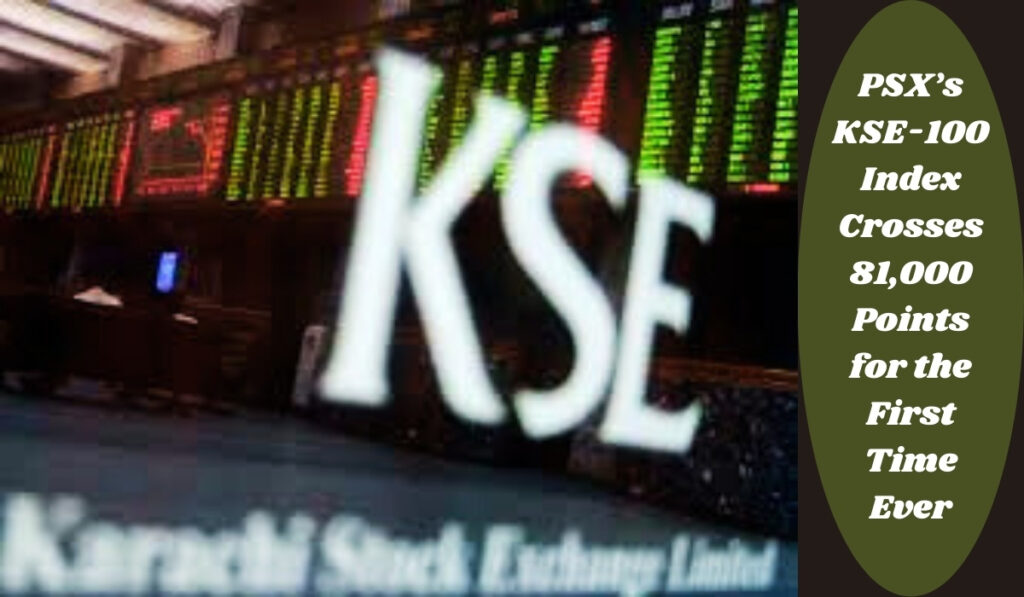Introduction
It was a landmark moment for the Pakistan Stock Exchange (PSX) when its benchmark KSE-100 Index briefly crossed the 81,000 mark. This milestone is a testament to the strength and resilience of the market amidst various economic challenges. In this article, we will delve into the journey that led to this achievement, analyze the factors contributing to this rise, and explore what it means for investors and the economy as a whole.
Background of PSX and KSE-100 Index
What is PSX?
The Pakistan Stock Exchange, commonly known as PSX, is the main stock exchange of Pakistan. It was formed in 2016 from the merger of the Karachi, Lahore, and Islamabad stock exchanges. PSX provides a platform for buying and selling securities such as shares, bonds, and derivatives.
Understanding the KSE-100 Index
The KSE-100 Index is the flagship index of PSX, comprising the top 100 companies based on market capitalization. It serves as a barometer for the overall performance of the stock market and is closely watched by investors, analysts, and policymakers.
Historical Performance of KSE-100
Historically, the KSE-100 Index has seen its fair share of ups and downs. From the highs of the early 2000s to the lows during periods of political and economic instability, the index has been a reflection of the country’s economic health. The journey to 81,000 is no different, marked by significant milestones and contributions from various sectors.
The Journey to 81,000
Key Milestones Along the Way
The path to crossing the 81,000 mark was paved with several key milestones. From breaking the 50,000 barrier in 2017 to steadily climbing upwards despite the pandemic-induced market volatility, each milestone showcased the resilience and growth potential of the PSX.
Major Contributors to the Rise
Industry Breakdown
Several industries played a pivotal role in pushing the KSE-100 to new heights. The banking sector, with its robust financial performance, and the oil and gas sector, driven by rising global oil prices, were among the top contributors. Additionally, the telecommunications and technology sectors saw substantial growth, reflecting the digital transformation wave sweeping across the country.
Top Performing Companies
Companies like HBL, OGDC, and PTCL were at the forefront of this surge. Their strong financial results, coupled with strategic expansions and investments, bolstered investor confidence and drove the index upwards.
Factors Behind the Surge
Economic Indicators
Positive economic indicators such as GDP growth, controlled inflation rates, and a stable currency played a significant role in boosting market sentiment. These indicators signaled a healthier economic environment, encouraging both local and foreign investors to invest in the stock market.
Government Policies and Reforms
Proactive government policies and reforms aimed at improving the business environment also contributed to the market’s rise. Initiatives to reduce corporate tax rates, streamline regulatory procedures, and promote ease of doing business attracted new investments and encouraged existing businesses to expand.
Foreign Investments
Increased foreign direct investment (FDI) and portfolio investments were crucial in driving the index upwards. Foreign investors, lured by the potential for high returns and the improving economic landscape, poured capital into the market, further fueling its growth.
Market Sentiments and Investor Reactions
Short-Term Impacts
The immediate reaction to the index crossing 81,000 was one of euphoria and optimism. Investors rushed to capitalize on the upward momentum, leading to a surge in trading volumes and liquidity. This short-term bullish sentiment was evident in the rapid rise of stock prices across various sectors.
Long-Term Implications
In the long run, the implications of this milestone are far-reaching. It signals a strong and resilient market capable of withstanding economic shocks and challenges. For investors, it presents new opportunities for growth and diversification. However, it also necessitates cautious optimism, as market corrections and volatility are inherent in any stock market.
Expert Opinions and Analysis
Bullish vs. Bearish Perspectives
Market experts are divided in their opinions on the sustainability of this rise. Bullish analysts argue that the market has strong fundamentals and is poised for further growth, driven by continued economic reforms and increasing foreign investments. On the other hand, bearish analysts caution against potential overvaluation and the risk of a market correction, emphasizing the need for careful and strategic investment decisions.
Predictions for the Future
Looking ahead, experts predict a mixed outlook for the KSE-100 Index. While some foresee continued growth and stability, others warn of potential headwinds such as political instability, global economic uncertainties, and domestic policy shifts that could impact market performance.
Conclusion
The KSE-100 Index crossing the 81,000 mark is a significant milestone for the Pakistan Stock Exchange and the country’s economy. It reflects the market’s resilience and potential for growth amidst various challenges. While the road ahead may be uncertain, this achievement has undoubtedly set a new benchmark for future performance. Investors should remain informed and vigilant, balancing optimism with caution as they navigate the dynamic landscape of the stock market.

